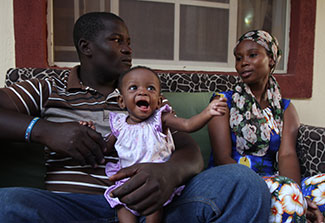
National Institute of Neurological Disorders and Stroke (NINDS): Developing neurological research capacity in LMICs
November / December 2016 | Volume 15, Number 6

© 2012 Akintunde Akinleye/NURHI, Courtesy of Photoshare
A Nigerian family in Karu village, on the outskirts of Nigeria's
capital, Abuja.
capital, Abuja.
By Karin Zeitvogel
Hundreds of millions of people around the world each year are afflicted with a neurological disorder - anything from epilepsy to stroke, Alzheimer's to Parkinson's disease and nearly 600 other conditions.
Called "one of the greatest threats to public health" by the WHO, neurological disorders exact a heavy toll on individuals of all ages, as well as the countries in which they reside. Diseases like stroke often leave sufferers disabled and cost national health care systems millions. An epileptic in Africa risks being ostracized from the community, and the medicines to treat sufferers of neurological disorders are often unaffordable in developing countries.
At the same time, it is in low- and middle-income countries (LMICs) that the incidence and prevalence of neurological disorders and diseases, particularly stroke, are growing fastest. Deaths from infectious diseases are falling as prevention and treatment improves. While people are living longer, many are adopting new dietary and activity patterns that put them at greater risk for noncommunicable diseases (NCDs), including stroke.

© 2015 Swati Sudarsan
Courtesy of Photoshare
A local schoolteacher sits with his son
in Nangodi, Ghana.
in Nangodi, Ghana.
At the NIH, the National Institute of Neurological Disorders and Stroke (NINDS) was established in 1950 to seek fundamental knowledge about the brain and nervous system, and to use that knowledge to reduce the burden of neurological disease. With an overall budget of nearly $1.7 billion, NINDS is Fogarty's most active NIH partner, helping support dozens of research and training awards on diverse topics such as epilepsy in Zambia, sickle cell disease in Nigeria and severe traumatic brain injury in Latin America.
NINDS recognizes that many of the countries with the largest neurological disease burdens have the fewest resources to devote to them.
"Working with global partners may help us identify innovative ways to treat and prevent neurological diseases, such as stroke," said Dr. Claudia Moy, NINDS program director. "We look for solutions that take into account each country’s unique cultural and economic setting, and support efforts to advance local research infrastructure."
As in many research fields, there are few neurological disease experts in developing countries. While the WHO recommends there be at least one neurologist for every 50,000 people, at least six African countries have none, according to a report published in World Neurology. NINDS has joined with Fogarty to support programs such as the Medical Education Partnership Initiative (MEPI), which helps African institutions strengthen medical education, build health research capacity and advance the careers of junior faculty.
NINDS has also participated in Fogarty's brain disorders research program, which funds research collaborations in developing countries, as well as the NIH Human Heredity and Health in Africa (H3Africa) Initiative, which aims to advance genomic studies across the continent.
More Information
- About the National Institute for Neurological Disorders and Stroke (NINDS) at NIH
- Funding information from NINDS
- History of NINDS from the NIH Almanac
- More neurological disorders resources:
- E-book: Neurological disorders: public health challenges
from the World Health Organization - Neurology in sub-Saharan Africa
World Neurology, October 16, 2014 - Neurological and mental disorders and diseases news, information and resources
from Fogarty - Improving Lives of People with Epilepsy in Zambia
Project example from Fogarty - Related Fogarty- and NIH-supported programs:
To view Adobe PDF files, download current, free accessible plug-ins from Adobe's website.





















.png)












No hay comentarios:
Publicar un comentario